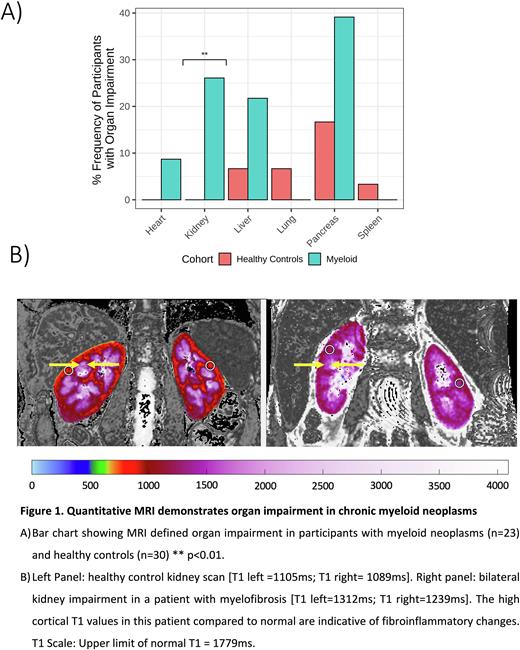Abstract
Background Chronic myeloid neoplasms have multi-organ consequences which are often under recognised. Multi-organ dysfunction has become increasingly relevant in light of COVID-19. CoverScan is a quantitative MRI technology which can determine the health of multiple organs in one scan. It has been utilised to detect organ damage in multi-organ diseases such as diabetes and long covid (Dennis A et al; BMJ Open2021).
Aims To determine multi-organ function in patients with chronic myeloid neoplasms, utilising quantitative MRI and blood biomarkers.
Methods We conducted a study of patients with myeloid neoplasms, who had recovered from COVID-19 (MyeloidScan REC 292188). We set out to determine the degree of organ impairment in the heart, lungs and visceral organs at serial timepoints. Inflammation was measured with quantitative T1 mapping. We compared the MyeloidScan patients to healthy controls (HC, n=30) who had not had COVID-19 by the time of the scan. We report findings from the visit 1 scans of 23 MyeloidScan patients and visit 2, six months later, in 11 patients.
Results Twenty three patients with chronic myeloid neoplasms have been enrolled to date (MPN, n = 14 [PV, n =4, ET, n = 7, MF, n = 3]; CML, n = 7; MDS n = 2;). The median (IQR) age of the patients was 56 years (47.5,65), with 48% being female. The median (IQR) age of the HC cohort was 48 years (44, 55) and the percentage of females was 63%. MyeloidScan patients had recovered from acute covid, with a median (IQR) time from positive covid test to scan of 137 (197, 243) days. MRI defined organ impairment was markedly higher in the MyeloidScan patients than in the healthy controls: pancreas (39% v 17% p-value = 0.066), kidneys (27% v 0% p-value = 0.004) and liver (23% v 6.7% p-value = 0.12) (Figure 1A). Single and multi-organ impairment was observed in 43% v 23% (p-value = 0.12) and 22% v 3.3% (p-value = 0.074) of patients and healthy controls respectively. Only 1/7 (14%) of the patients with an elevated kidney T1 (Figure 1B) had a corresponding elevated serum creatinine. In contrast, 100% of the patients with MRI defined liver impairment had an elevated bilirubin and/or alanine transaminase. 9 patients with visit 1 findings have undergone their timepoint 2 scan, with 67% having persistent organ impairment 6 months later. Notably, 100% of the patients with abnormal liver and kidney MRI scans at baseline, had persistent abnormalities at their visit 2 scan (n=7).
Of the patients with ET (n=7), 5 were <65 years old and not on cytoreductive therapy. The remaining 2 patients, were receiving cytoreduction with hydroxycarbamide and pegylated interferon respectively. The MRI abnormalities were detected in the younger ET patients and not in the 2 older patients. Of the patients with PV (n=4) all were also <65 years old; 3 were on venesection programs and 1 was being actively monitored. 3 patients had abnormal liver scans, 2/3 also had abnormal pancreas imaging but all had preserved kidney function on MRI, in contrast to patients with ET and MF. Of note, 2/3 patients with MF had markedly elevated kidney T1 but not liver T1. All of the patients with CML (n=5) were in a major molecular remission (MMR). 2 had an abnormal pancreas scan and 1 had abnormal kidneys with a normal serum creatinine.
Discussion CoverScan MRI has revealed a high prevalence of multi-organ impairment in patients with chronic myeloid neoplasms. Due to the limitations of our study design and numbers, it is not possible to easily distinguish between myeloid neoplasm-associated end organ damage, post COVID-19 effects, or a combination of the two. Amongst the patient subgroups, it was striking that renal impairment was evident on MRI in patients with normal serum biomarkers such as creatinine. This may suggest the possibility of using quantitative MRI as an early detection tool for fibroinflammatory disease in patients with myeloid neoplasms. Of note, although a small cohort, our data demonstrates multi-organ impairment in younger patients with MPNs. The clinical implications at this stage are uncertain, but as renal function is a prognostic factor in MPN, examination of larger patient groups, including those without previous COVID infection is warranted. Further studies incorporating multi organ imaging into diagnostic and stratification pathways are required.
Disclosures
Telford:Perspectum Ltd: Current Employment, Current holder of stock options in a privately-held company. Roca-Fernandez:Perspectum Ltd: Current Employment, Current holder of stock options in a privately-held company. Rymell:Perspectum Ltd: Current Employment, Current holder of stock options in a privately-held company. Eichert:Perspectum Ltd: Current Employment, Current holder of stock options in a privately-held company. Pansini:Perspectum Ltd: Current Employment, Current holder of stock options in a privately-held company. Thomaides-Brears:Perspectum Ltd: Current Employment, Current equity holder in private company, Current holder of stock options in a privately-held company. Psaila:Galecto: Research Funding; Novartis: Consultancy, Honoraria, Speakers Bureau; Blueprint Therapeutics: Consultancy; Constellation Therapeutics: Consultancy; Alethiomics: Consultancy, Current equity holder in private company, Honoraria, Other: Co-founder , Research Funding; Evotec: Research Funding. Mead:Celgene/BMS: Consultancy, Research Funding, Speakers Bureau; AbbVie: Consultancy, Speakers Bureau; CTI: Consultancy, Speakers Bureau; Sierra Oncology: Consultancy, Speakers Bureau; Karyopharm: Consultancy, Speakers Bureau; Sensyn: Consultancy, Speakers Bureau; Incyte: Consultancy, Speakers Bureau; Galecto: Consultancy, Research Funding, Speakers Bureau; Pfizer: Consultancy, Speakers Bureau; Gilead: Consultancy, Speakers Bureau; Alethiomics Ltd: Consultancy, Current equity holder in private company, Other: Co-founder and equity holder, Research Funding; Novartis: Consultancy, Honoraria, Research Funding, Speakers Bureau.
Author notes
Asterisk with author names denotes non-ASH members.


This feature is available to Subscribers Only
Sign In or Create an Account Close Modal